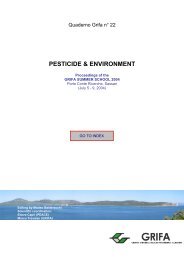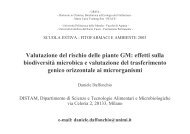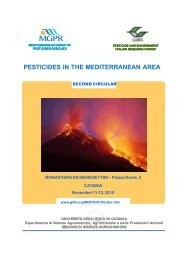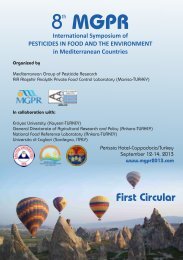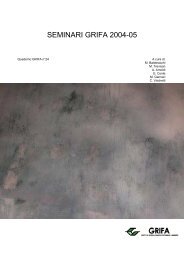International Congress BIOLOGICAL PRODUCTS - Gruppo di ...
International Congress BIOLOGICAL PRODUCTS - Gruppo di ...
International Congress BIOLOGICAL PRODUCTS - Gruppo di ...
Create successful ePaper yourself
Turn your PDF publications into a flip-book with our unique Google optimized e-Paper software.
15<br />
ORGANIC WHEAT QUALITY AND PRODUCTION: THE RESULTS OF THREE YEARS OF TRIALS<br />
Fabio Fusari, Antonella Petrini<br />
The relevant increasing of farms and areas interested in organic productions in Italy draws attention to the need of an<br />
experimentation which can help this sector for an equilibrate growth. CERMIS (Research and Experimental Centre for<br />
Plant Improvement “N. Strampelli”), in collaboration with ASSAM (Agency for Food and Agriculture Services in<br />
Marche region), has begun in 1998 an experimental project in the sector of autumn-vernal cereals in which the main<br />
objectives are identifying the varieties to employ and optimizing the cultivation techniques. A correct varietal choice is<br />
essential, in organic agriculture, in order to obtain acceptable productive and qualitative results. The morphological and<br />
physiological characteristics which make cultivars suitable for this kind of cultivation are: rusticity, resistance or<br />
tolerance to the main phytopathies, ability of competition with weeds and greater efficiency in the use of nitrogen. An<br />
other aspect to consider, especially in the case of bread wheat, is the qualitative one, because the milling industry<br />
requires <strong>di</strong>stinct technological characteristics of the stocks accor<strong>di</strong>ng to the <strong>di</strong>fferent kinds of product (bread, biscuits,<br />
‘panettone’, etc.). Qualitative characteristics, intrinsic in a specific variety, are also affected by pedological, climatic<br />
and agronomic factors; so the evaluation of each single variety within a cultivation system is fundamental, especially<br />
when the external inputs are reduced as in the case of organic agriculture.<br />
The activity within the project<br />
Since from 1998 a parcel trial for the varietal comparison of bread wheat has been carried out by an organic farm<br />
situated along the valley of Potenza river (Macerata, Italy) on a me<strong>di</strong>ally fertile, tendentially clayey, soil. The<br />
cultivation techniques which have been adopted are the ones usually employed by that farm, admitted by the EC Reg.<br />
2092/91. The main agronomic and qualitative attributes have been taken and statistically analysed in accordance with<br />
the methodologies adopted by the wheat national network in Italy. The twenty bread wheat varieties that have been<br />
evaluated have been chosen, between the ones registered to the national catalogue, on the basis of their agronomic,<br />
merchan<strong>di</strong>se (qualitative classes) and commercial characteristics. Also the old cultivar Abbondanza has been inserted in<br />
the trial, in order to verify its behaviour in the case of an organic method of cultivation.<br />
Table 1 - Production indexes (*) of the tested varieties<br />
Variety name 1999 2000 2001 average<br />
ABBONDANZA 108 101 134 114<br />
EUREKA 101 109 135 115<br />
SERIO 113 104 108 108<br />
CENTAURO 109 111 97 105<br />
BOLERO 93 110 94 99<br />
COLFIORITO 107 92 90 96<br />
SAGITTARIO 86 99 101 95<br />
ENESCO 91 101 87 93<br />
MIETI 109 95 63 89<br />
PANDAS 103 113 36 84<br />
SIBILLA 87 98 73 86<br />
VALLEROSA 95 86 67 83<br />
SANGIACOMO 98 81 61 80<br />
ETECHO 157 157<br />
GUADALUPE 140 140<br />
TREMIE 128 128<br />
TIBET 124 124<br />
GENIO 118 118<br />
BILANCIA 109 109<br />
SIRMIONE 78 78<br />
Field average (t/ha) 3,39 2,75 2,11 2,65<br />
(*) 100= field average<br />
YEAR<br />
Results<br />
From the analysis of mean results of the thirteen varieties common to the three years of trials, it’s evident that a<br />
progressive loss of yields over the years (graph 1), due mainly to the anomalous meteorological trend during the two<br />
last grain seasons, has taken place.<br />
87<br />
4,0<br />
3,5<br />
3,0<br />
2,5<br />
2,0<br />
1,5<br />
1,0<br />
0,5<br />
0,0<br />
180<br />
160<br />
140<br />
120<br />
100<br />
80<br />
60<br />
40<br />
20<br />
0<br />
Graph 1 - Average yield (t/ha) of the 13 varieties<br />
common to the three years of trials<br />
1999 2000 2001<br />
Graph 2 - Mean alveographic parameters (W<br />
and P/L) during the three years of trials<br />
w P/L<br />
1999 2000 2001<br />
PDF creato con FinePrint pdfFactory versione <strong>di</strong>mostrativa http://www.secom.re.it/fineprint<br />
1,0<br />
0,9<br />
0,8<br />
0,7<br />
0,6<br />
0,5<br />
0,4<br />
0,3<br />
0,2<br />
0,1<br />
0,0



